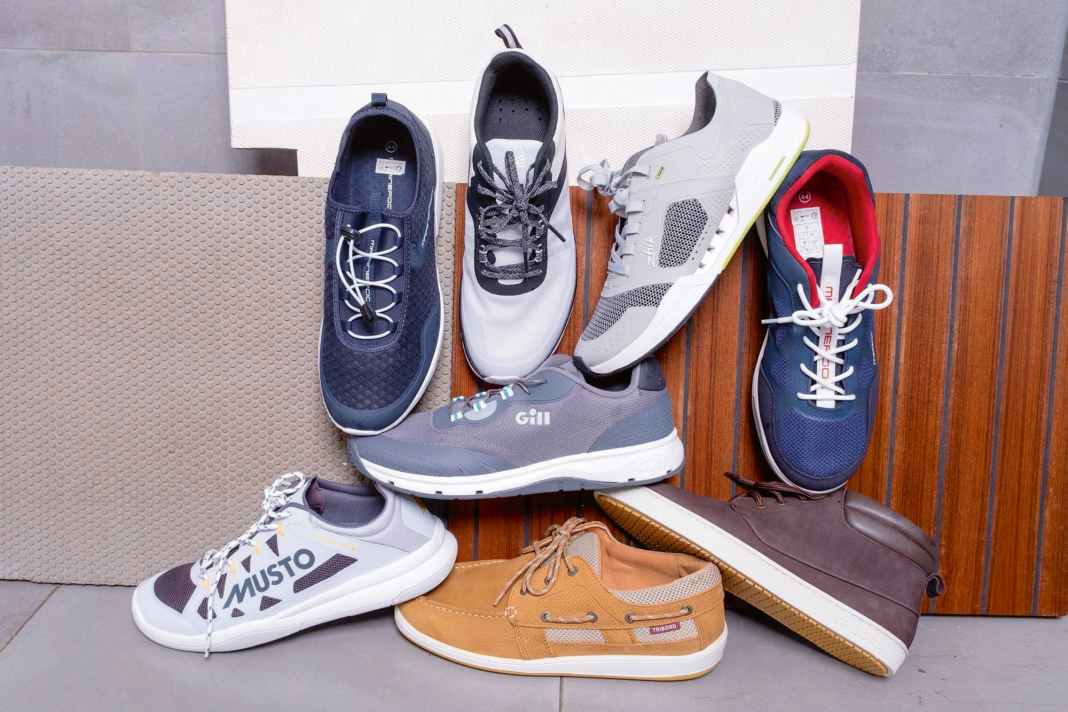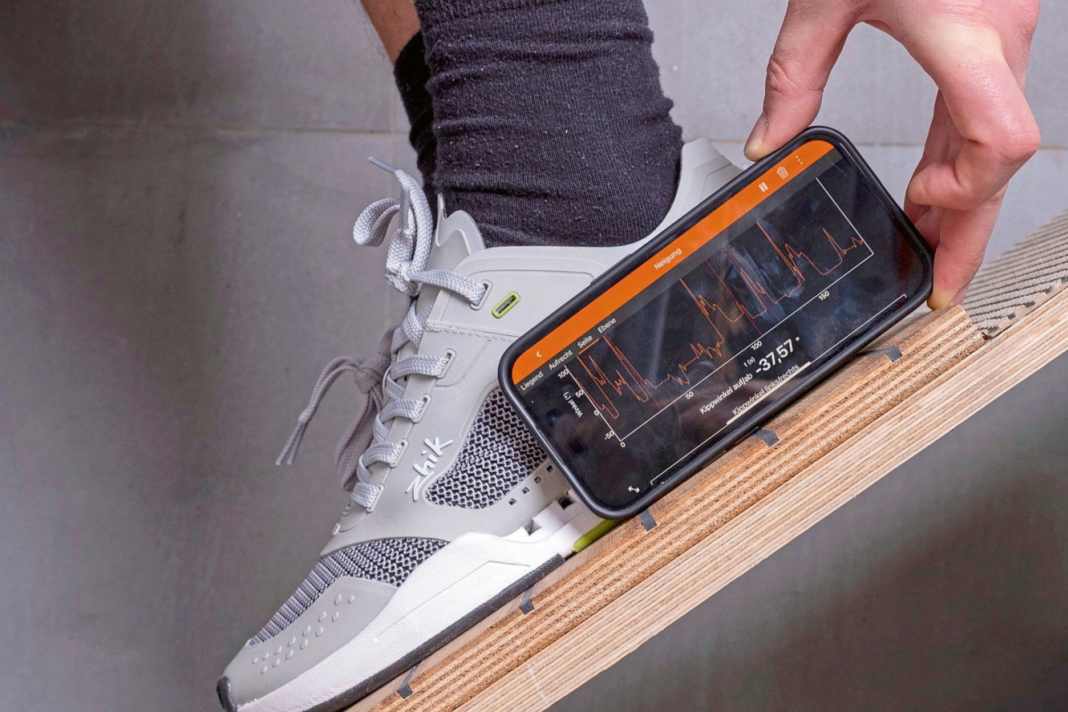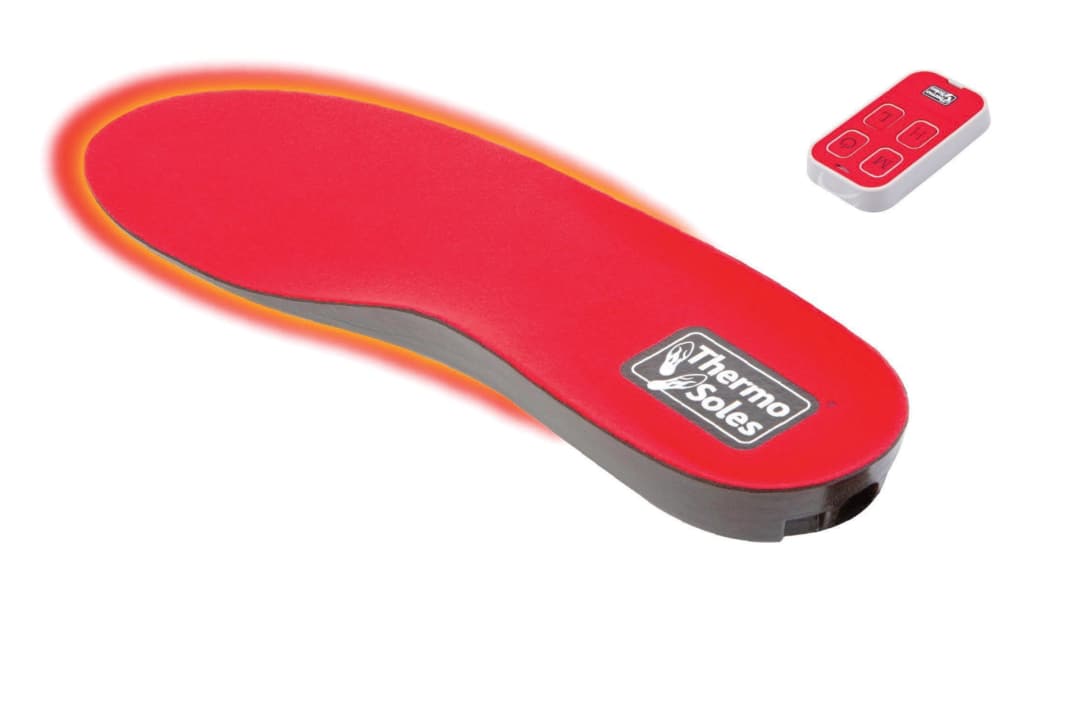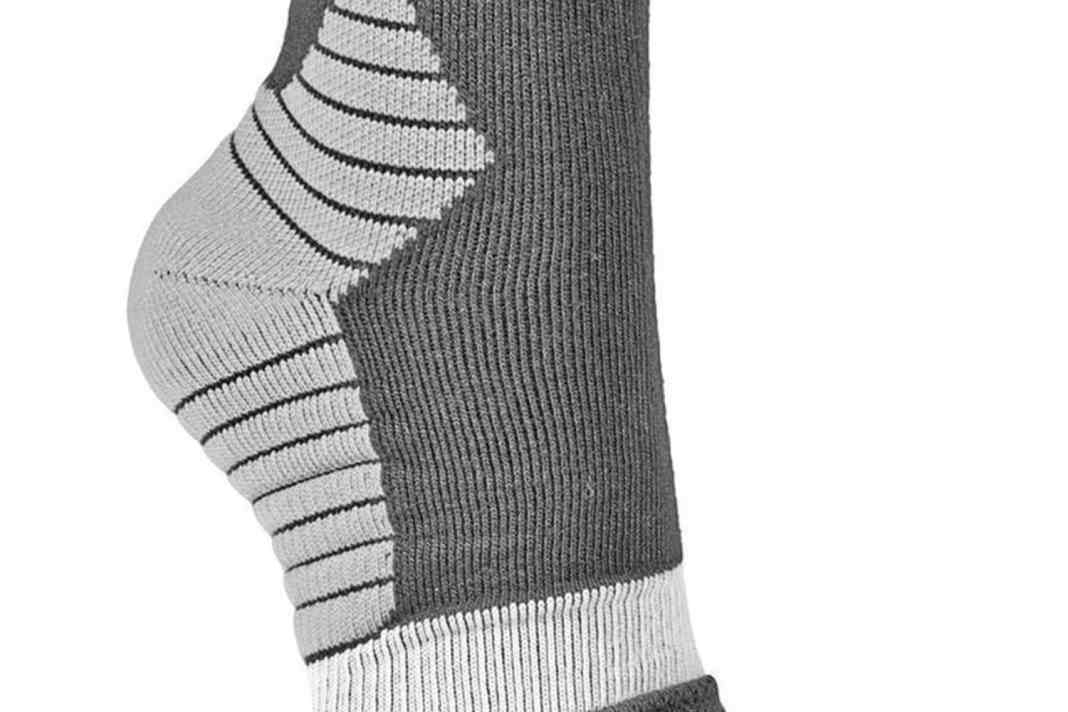





Good shoes are essential on board and the most important piece of personal equipment next to your oilskins. Firstly because their slip-resistant soles ensure a secure footing on deck. Bare feet quickly become very slippery on wet surfaces, so there is an acute risk of injury or, in the worst case, falling overboard. On-board shoes also protect your toes, as it's easy to bump into them on the way to the foredeck. In addition to providing grip on deck and protecting the feet, the shoes must be breathable, i.e. ensure a good foot climate, and of course also fit comfortably.
We tested eight current board shoes that are either brand new or have been revised for the coming season. These included Gill with the Verso Race Trainer and Marinepool with the two models Ketch and Ocean Spirit. Tribord, the house brand of sporting goods giant Decathlon, sent three shoes into the race: the classic-looking Clipper V2, the sporty Race Mund and the Sailing 500, a model that is only recognisable as a sailing shoe when you take a second look at the sole. Fresh from Munich, we received the models from Musto (Dynamic Pro II Adapt) and Zhik (Fuze), which are already tried and tested and have now been updated for the new season.
Read more equipment tests:
The on-board shoes from Sailracing, Crocs and Helly Hansen did not reach us in time for the test. Women's shoes are not included in the test field this time. However, the 2020 test winner from Gill is still available from many retailers.
In the test, ten values were determined for each shoe, which ultimately decided the overall ranking. Six of these values relate to the secure grip on deck. Three deck coverings in two conditions, dry and wet, resulted in six measured values. A maximum of 60 points were awarded here. In addition, there are three weight measurements for the new, wet and twelve-hour dried shoe. Water absorption and drying behaviour can be derived from the latter three values. A maximum of 30 points was awarded here. Finally, the lowest possible dirt absorption of the sole earned a maximum of 10 points.
Test results
On the inclined plane with the three different deck coverings teak, textured GRP and Treadmaster, most of the models in the test held up to an angle of attack of between 30 and 40 degrees. This is, of course, significantly more than the position you would feel comfortable with on board a sports boat. However, the value was also measured when stationary, with a static load. When you are moving on board, the loads are more dynamic. However, the test method enables repeatable results and reveals the differences between the soles particularly well. The more incline a shoe withstands in the test is transferable to the performance in everyday life on board.
One positive result to start with: all the board shoes in the test only lost their grip slowly when the surface became too steep. They then began to slip slowly, no model suddenly lost its grip and slipped uncontrollably. There have already been negative examples of this in previous tests. What is unpleasant in the test can quickly become dangerous on board. All models made a good impression here.
Board shoes have different soles
The model with the best grip on the sloping decks was the Race M from Tribord/Decathlon. On a dry teak deck, the shoes achieved an angle of inclination of 38 degrees. A very good value. In the last test in 2020, the test winner among the women's shoes, the Race Trainer Women from Gill, reached 40 degrees. With wet decks and soles, the values are slightly lower.
The Fuze from Zhik were almost on a par with the Race M from Tribord. The Zhik sole has also impressed in previous tests and is also at the forefront this time. Also very good and only just behind Race M and Fuze is the model Dynamic Pro II Adapt from Musto. The Verso Race Trainer from Gill takes the next place in terms of performance on the slope, followed by the Sailing 500 from Tribord. It would be expected that these would be on a par with the Clipper V2 from Tribord should be. The soles of the two models are very similar. However, a closer look reveals that there are small differences in the tread depth.
This also explains the differences in the slip test. This is because the Ocean Spirit from Marinepool is ahead of the Sailing 500 from Tribord. Unfortunately, the Ketch model from Marinepool was not convincing in this test discipline. All measured angles of inclination were well below 30 degrees.
Another exciting detail for everyday life on board is a sole detail that has nothing to do with grip on deck: the water drains. These drains can be found in four of the eight models tested: the Verso Race Trainer from Gill, Ketch from Marinepool, Race M from Tribord and Fuze from Zhik. Race M and Fuze do not have a direct opening at the bottom; the drains open at the side of the sole, a little above the ground. The advantage is that you don't get your feet wet directly on wet surfaces.
The Dynamic Pro II Adapt from Musto has a special feature: the sole has the typical openings for drainage, but these do not go through to the inside of the shoe. The model has already been revised several times and initially had large drainage holes, but these were closed as the feet became damp when walking over wet surfaces.
Sporty look almost throughout
Six of the eight board shoes in the test look sporty, with lots of mesh material and plastic. Only the Clipper V2 and Sailing 500 models from Tribord stand out visually. The Clipper V2 look like classic deck shoes made of leather. The Sailing 500 reach over the ankle and do not look like typical deck shoes. However, the sole fulfils the requirements and the model is explicitly marketed by Decathlon as a board shoe. In terms of design, the Ketch model from Marinepool differs from the masses as it is designed like a slip-on shoe. You slip into it, the laces regulate the width of the shoe, but it cannot be opened as wide as you like with loose laces. This has advantages because the shoe fits tighter, but can also be more awkward to put on.
The winners of 2020
Apart from the Tribord models with a leather look, the board shoes in the test field are very airy. A lot of mesh material is used for the upper material. Another striking feature of the workmanship is that almost all models have few seams. Almost all joints are glued. This is most noticeable in the Fuze model from Zhik. Here, the transitions between different materials look very organic, without any seams that could chafe the foot. The Clipper V2, on the other hand, has a very classic design.
Ventilation and drying
The use of mesh material in most models prevents sweating. In addition, board shoes and feet can dry more quickly if they have been soaked by splashing water. The less padding or lining there is in the shoe, the less water it absorbs and the faster it dries again afterwards. This worked best with the Fuze from Zhik. The shoes are very airy and there are no materials that absorb water. The soaked but drained shoe weighs over 60 grams more than before. However, this amount of water has evaporated completely after 12 hours of drying. This is a great advantage if you don't want to get into clammy, cold board shoes the next morning.
Like the Verso Race Trainers from Gill, for example, which still had 90 millilitres of water in the fabric the next morning. As a result, they still felt really wet. The same could also be diagnosed for the Ocean Spirit after the drying time. The Dynamic Pro II Adapt from Musto and the Race M from Tribord only felt slightly clammy. The Sailing 500 shoes from Tribord were an exception. They still contained 23 grams of water after the 12-hour drying time, but felt dry to the touch. This means that the moisture was still in the material, but could no longer be felt.
As with drainage, particularly good ventilation can also be a gateway for moisture. The mesh material can also allow splash water to find its way into the shoe more quickly. Here, the more classic models may have an advantage in drizzle or spray, as feet stay dry for longer. However, once these shoes are really wet, they take longer to dry again.
On-board shoes in unfamiliar territory - ashore
The dirt absorption test is controversial among many manufacturers. They say that sailing shoes should be worn on board and not on land. The soft rubber or plastic soles increase grip on wet surfaces, but also wear out more quickly when going ashore on tarmac, stone or gravel.
The shoe manufacturers point out that you should change your shoes before going to the harbour office. Preferably with suitable road shoes. We still carry out the test, in which a defined route is walked over a gravel path with stones of different sizes, in order to determine how many stones collect in the sole profile of the boat shoes. These would inevitably be scattered on board after going ashore or could scratch the deck covering and floorboards.
It is pleasing to note that the shoes collected very few stones in the current test. Only a few very small stones got caught in the soles of the Fuze from Zhik and the Clipper V2 from Tribord. There were even fewer in the tread of the Verso Race Trainer from Gill. In the other models, nothing even got stuck in the sole structure.
The Race M model from Tribord scored the most points in the test, making it the test winner. However, it was closely followed by Zhik with the Fuze and Musto with the Dynamic Pro II Adapt. They are all within four points of each other. What they all have in common is that they are very light, offer very good grip on deck and dry quickly. There are major differences in price. The Tribord board shoes cost 40 euros, which also makes them the price-performance tip. In contrast, the Fuze costs 160 euros and the Dynamic Pro II Adapt 159 euros.
The models Ocean Spirit from Marinepool, Clipper V2 from Tribord and Verso Race Trainer from Gill also achieved very good results.
The Ketch board shoes from Marinepool, on the other hand, were not convincing in the slip test on the test deck surfaces. Values of around 25 degrees were measured throughout. This means that this sole is not at all competitive with the rest of the test field.
Conclusion on the test
Without question, it is highly advisable to try on board shoes. The table includes an assessment of wearing comfort. However, as this value is very individual, it is not included in the score. The same applies to appearance; it is up to each individual to decide whether the test winner is also visually appealing.
Fortunately, the test field also offers other very good alternatives. This is why all results are listed in detail in the table. This means that grip, drying behaviour and dirt absorption can be weighed up against each other. Almost all shoes achieved good results in the test, and the test winner is not the only good sailing shoe to be emphasised. With the exception of the Ketch model from Marinepool, which failed to impress with its grip on the test deck surfaces, all other models are recommendable. There are seven pairs to choose from. Together with a fitting, you can then choose your individual favourite. This does not necessarily have to be the test winner.
However, the test results cannot provide any indication of how long the shoes will last. Experience shows that boat shoes can still look intact, but still lose their once very good grip on deck. At some point, the sole no longer provides any holding power. The grip is not only created by the sole profile, but also comes mainly from the soft rubber compounds. This allows the material to adapt very well to the ground and provide optimum grip. However, if the sole loses its elasticity, for example if plasticisers diffuse out of the material, the surface becomes harder and the shoe becomes more slippery as a result. If the board shoes no longer have sufficient grip, the only solution is usually to replace them. However, the old shoes can still be used when going ashore. The manufacturers have nothing against this.
How we tested the board shoes




We create reproducible conditions for the test. On board, a change in the weather would also change the conditions for the test. Under laboratory conditions, all shoes have the same chance. Test results from different years can also be compared. The grip of the sole is tested on a teak pole deck, structured GRP and the Treadmaster deck covering. We determine the maximum inclination at which the shoe still holds securely. This is repeated with a wet deck and wet soles. We also measure the water absorption and drying behaviour by weighing. Finally, we walk 200 metres over a gravel path to see how many stones get caught in the sole structure. This test is controversial among manufacturers, as on-board shoes should only be worn on board.
On hot soles



All the shoes in the test have removable insoles. So why not replace them with a sole that can also heat? The insoles from Thermo Soles make this possible. They come with electric heating elements, an integrated rechargeable battery and temperature control.
Each sole contains a lithium-polymer battery with a capacity of 5.5 watt hours. Depending on the outside temperature, this should provide between two and eight hours of foot heating. The batteries can be recharged using the mains adapter supplied. Shore power is required for this. The charging process takes up to 15 hours. The Thermo Soles have a heating range between 38 and 48 degrees Celsius. The insoles should not be immersed in water. Price: 110 euros >> available here.
How the shoe becomes a boot



Dry feet can make all the difference in cold weather. With socks from Sealskinz, you can do this without boots. The socks are completely waterproof. They are made from a three-layer material. The nylon knit on the outside makes them indistinguishable from normal socks. A membrane is used as the middle layer. This prevents water from getting in, but allows moisture to get out. This reduces the risk of sweaty feet. On the inside, the membrane is protected by a fabric made from bamboo fibres. This also absorbs a lot of moisture, which keeps your feet feeling dry. Sealskinz socks are available in various colours from 37 euros.

